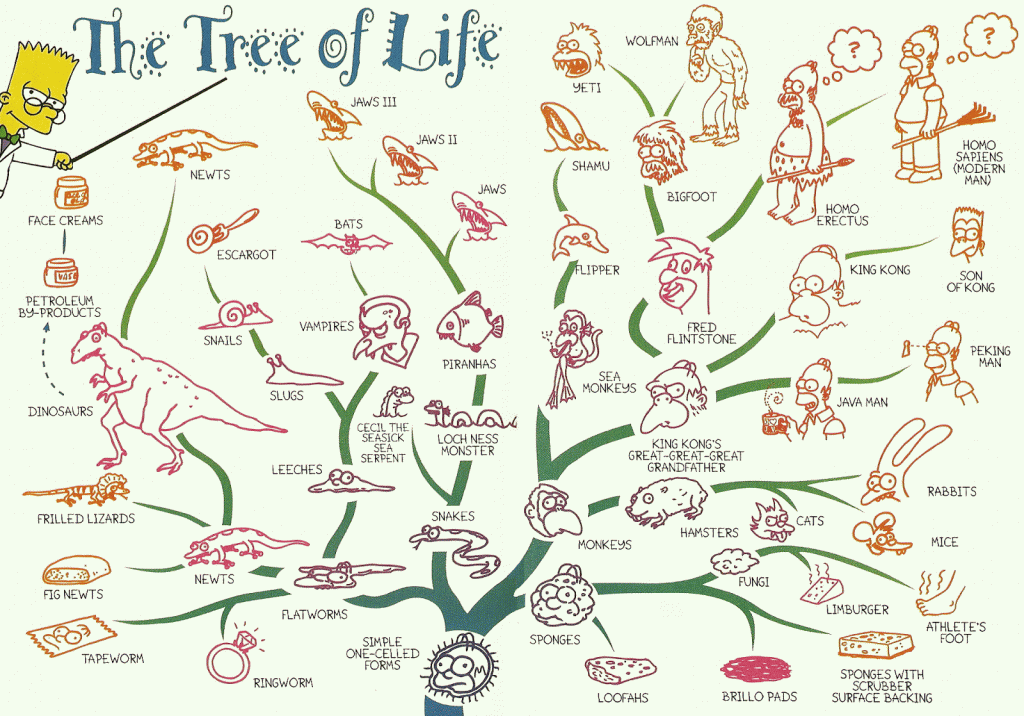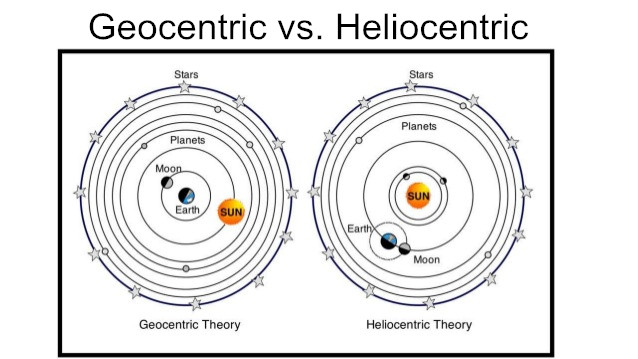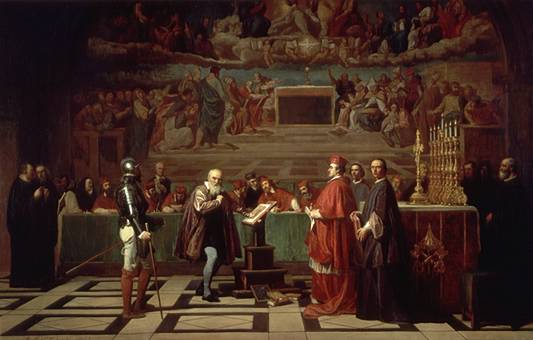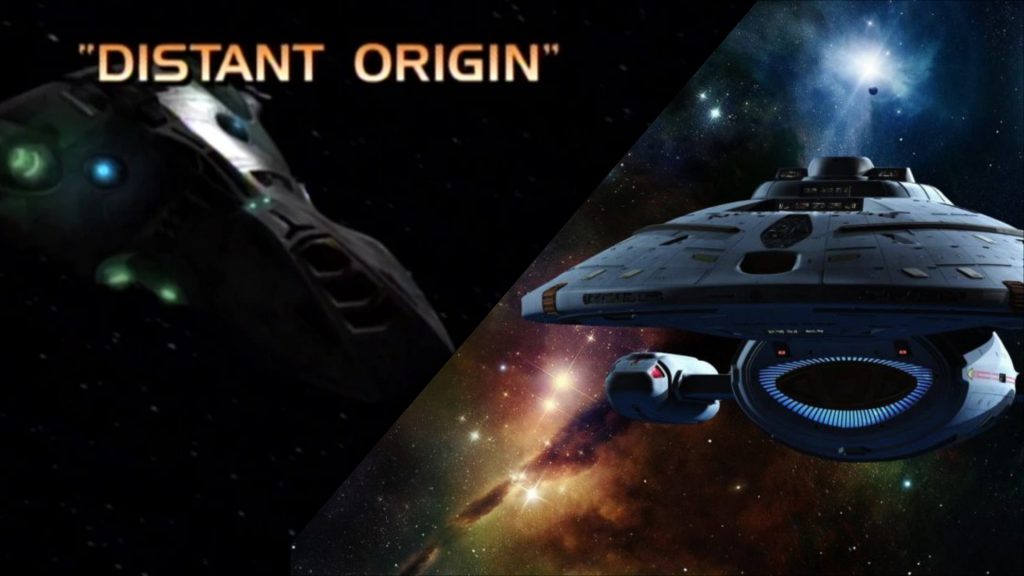Dinosaurs in The Delta Quadrant?
Star Trek: Voyager, Science, and Catholicism
Guest post by Rebecca Salcedo, one of our current Young Scientist Program (YSP) participants. Rebecca has an undergraduate degree in molecular environmental biology from UC Berkeley and is currently a Masters student in microbiology at San Francisco State University. She’s a current BMSIS YSP at NASA Ames where she’s working with Dr. Alfonso Davila and Dr. Paul Wilburn on a project considering how life could develop and thrive on Mars by studying microbes from the Atacama Desert in Chile here on Earth.
The Star Trek franchise is one of the most famous science fiction series in today’s world. Starting in the late 60’s, the franchise has had pretty much continuous spinoffs. One such spinoff was “Star Trek: Voyager”, which shared the adventures of the crew of a starship that was deserted in the fictional region of the galaxy known as the Delta Quadrant as well as the crew’s journey as their way home to Earth. Star Trek has always been a family-friendly, entertaining, adventure show making strides of equality, representation, and special effects. It’s also known as one of the more scientifically accurate science fiction shows. From the very start, their depictions of matter-antimatter energy generation, deflector beams, warp drives, and worm holes have been accurate enough to make even NASA scientists happy (here’s a nice list compiled by David Allen Batchelor from the NASA Goddard Space Flight Center). Having an accurate representation tends to make a scientist’s heart sing, as not only is it fun to see your discipline correctly represented but it also can help to make science more accessible to the general public.

Probably the most exciting aspect of science in Star Trek is their exploration of alien life in the galaxy. As a biologist, most of Star Trek’s astrophysics and engineering terms go right over my head, but when the characters start talking about alien life on M class planets I do a little dance. One of the more biology-heavy episodes in Voyager is called “Distant Origin.” The episode starts off with a group of aliens from a race called the Voth discovering a human Starfleet officer’s remains on a planet. They discover that this person is a distant evolutionary relative of their own and the researchers are ecstatic, as this supports their Distant Origin Theory: the concept that their species’ ancestors evolved somewhere else in the galaxy and only later traveled to the part of space they occupy now. However, they’re also nervous as the Voth Elder’s adamantly deny this theory in favor of their own: that the Voth evolved where they live and therefore have an evolutionary right to the space they’re in. Various adventures ensue between the two species as the Voyager crew finds themselves in the middle of this Voth conflict.
The especially neat thing about this episode for me, was that the analysis of genomes to generate evolutionary relationships is entirely correct! In the TV show, both the Voth and Starfleet scientists compare the genes of the Voth against Humans in order to determine that they’re related, suggesting they both came from the same planet (aka Earth). Comparing genomic similarities and differences is exactly how scientists today determine our distant relatives and how closely we are related to them (here’s a good breakdown of the study of these relationships by Khan Academy). Evolutionary ties can be determined with a variety of traits, but DNA has become our most accurate method in recent decades. An example in our own scientific progress would be looking at human evolution and the hominid family tree. Homo sapiens (humans) are not the only hominid to have ever lived on this planet; there used to be a variety of others, often overlapping and living together (if you want to check out human evolution head over to this site from the Smithsonian for a fun interactive map of our history). In order to learn about all those relationships scientists studied the many traits, including DNA, from the specimens they could find to determine how each species is similar, different, and when those similarities or differences arose and created a new species (aka a speciation event). If you’re particularly interested in the nitty gritty of that process, here’s a paper that explains how molecular anthropologists used ancient DNA to construct our evolution. The fun thing about this method is that DNA is universal (at least for life as we know it), so we can use this technique for any living thing! If we want to see how similar humans are to, say, a banana, a scientist can look at the two genomes and determine how they’re connected on the tree of life.


Another interesting overlap between this episode of Star Trek: Voyager and “real” science is the concept of the Distant Origin Theory and its similarity to the theory of Panspermia. Panspermia is the theory that life (or at least life’s building blocks) are present all over the universe and instead of life arising on Earth it was transported here, probably on a comet or asteroid. While it sounds far-fetched, it’s something that even NASA scientists consider in the search for extraterrestrial life (check out this cool article from NASA Astrobiology for more information).
However, not everything presented in this episode is factually accurate, which is to be expected in a science fiction television show. Voyager’s Captain, Janeway, and the EMH (Emergency Medical Hologram; aka the ship’s doctor) use the holodeck to simulate species evolution over 60 million years, from the dinosaur that the Voth evolved from, the Hadrosaur genus, to the Voth themselves. While some mutations are known to happen on a specific time scale (that’s how we’re able to determine how long-ago species diverged from each other, it’s known as the molecular clock) and could theorize what a certain mutation might do to an organism (for example, a mutation in a key gene for survival would probably end up killing an organism and ending the lineage, while another in a simple gene, like the one that determines eye color, could make a predicable change in the physiology of a species), to predict 60 million years of evolution with such accuracy seems like too far of a stretch. While an interesting and fun concept, and who knows what 24th century science and technology will be able to do, what is depicted in the show just isn’t realistic for what we can do today.
A very important topic touched on in this episode was the interaction between science and religion and what can happen when one tries to control the spread of information. One of the more famous examples of this is the conflict between the astronomer Galileo and the Roman Catholic Church. When Galileo was doing his research in 1633, the primary belief was that the Sun revolved around the Earth, a geocentric view of the universe. However, Galileo was one of the first scientists in Renaissance Europe to come forward with a heliocentric view, that the Earth and all other planets revolve around the Sun. Many in the Church at that time saw heliocentrism as conflicting with such Biblical passages as, “The world also is established. It cannot be moved,” “He (the Lord) laid the foundations of the earth, that it should not be moved forever,” and “The sun also rises, and the sun goes down, and hurries to its place where it rises”. Unwilling to accept anything different, the Church made Galileo put his research on hold for over a decade and put him on house arrest for the rest of his life.

There have certainly been other instances where religion has butted heads with scientific endeavors and attempted to control the availability of scientifically-derived knowledge. More recently there has been the conflict of Creationism versus Evolution and what should be taught in primary schools. The scientific community tends to accept the theory of evolution for how life’s diversity arose and changed over time on this planet. However, in the Bible it’s stated that God created the world and its life in 7 days. Granted, this is based on a literal interpretation of the Bible which isn’t really the common viewpoint shared today, but there are still some religious groups and people attempting to alter the teaching of scientific information due to this literal interpretation. This has led to the debate of how to choose what to teach in the public-school system here in the USA: the scientific theory or the religious one? Do you teach both? Should parents, religious officials, or the school board be able to make that decision for children? Who gets the largest influence in that debate? Is it okay to let one side veto another? The question of teaching creationism versus evolution has been raised many times since with other smaller scale cases, and people are still debating what society’s responsibility to children should be with regard to this issue.
It’s worth noting that the relationship between science and religion wasn’t always rocky. Religious organizations, including the Catholic Church, have donated to and funded a lot of scientific research, including support for many medical facilities and hospitals (if you’re in the US, just google “catholic hospital near me” and at least one is bound to pop up!). Many famous scientists through history were also religious and at times their religious principles led them to scientific discoveries! Such as famed mathematician Isaac Barrow, who believed that repeated experiments lead to general principles because God’s will must be constant, otherwise “the great Author of the universe is unlike himself“. Additionally, now people are finding a way to accept both their religion and new scientific discoveries. Most Catholics now believe the Earth wasn’t made in 7 days, and that there has been evolution occurring for millions of years, but they also believe that God is directly involved in the process. These changes started to come slowly in the past, as the Church was hesitant, but they seem now willing to listen and learn to what scientists have to say.
In Distant Origin, leaning more towards the habits of the old Catholic Church, the Voth court of Elders refused to accept the Distant Origin Theory and threatened to send both the Voth scientists and the Voyager crew to prison camps unless they recant their story. While the Catholic Church may have done something similar when Galileo was around, it definitely wouldn’t happen today. Currently, the two fields aren’t in total agreement, with the Church opposing any stem cell research as well as any form of contraception. But between where we were and were we are now, there is a massive dialogue of cooperation between the two. Having the Voyager crew face the Voth’s head council’s decision with a modern outlook helps to display how dangerous any discipline (in this case, religion) can be when focused on controlling information, the public mindset, and set in an unwillingness to compromise when presented with new evidence. The episode emphasized the importance of having an open, cooperative dialogue between all disciplines and making information available to the public for their own analysis.

The writer of Voyager, Brannon Braga, noted that this episode was specifically a comment on the Galileo Affair, but the commentary on the control of information is a universal concern. Whether it’s a religious state, a dictator, a controlling government, or even the head of a family, limiting access to information and discoveries is a dangerous path that everyone needs to be wary of. In Distant Origin, the Voth Elder’s weren’t against science and actively supported other avenues of research in their society, but they were holding strong on a specific belief. Scientists can fall victim to this as well when a hypothesis of theirs is proven wrong. For example, the debate of when syphilis arrived in the Americas is a hot topic in anthropology and archeology. Here’s a good link that describes the two current theories and the history behind them. The key point here is that scientists can build entire careers off of one hypothesis, and if evidence arises that threatens that career they might try to poke unnecessary holes in perfectly sound science. Letting a secondary directive influence your science is a dangerous path and only acts to slow the progress of the field.

Distant Origin did a great job at airing out our scientific history and remind us that in our journey of exploration and discovery of our planet (and the universe) we need to remain open-minded and be willing to learn with the evidence we have. While tinged with a bit of science elitism, this episode of Star Trek: Voyager brings up a key point in science, being able to listen to the evidence even if it contradicts your hypothesis. If we want to discover the truth of the universe, we need to be willing to accept it.
